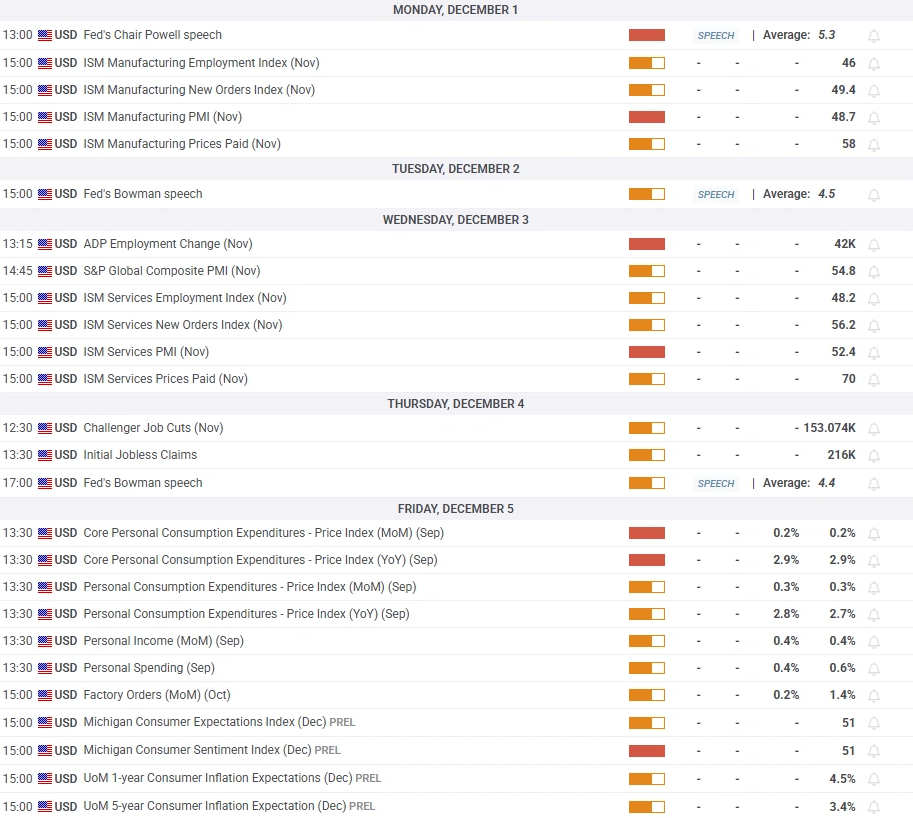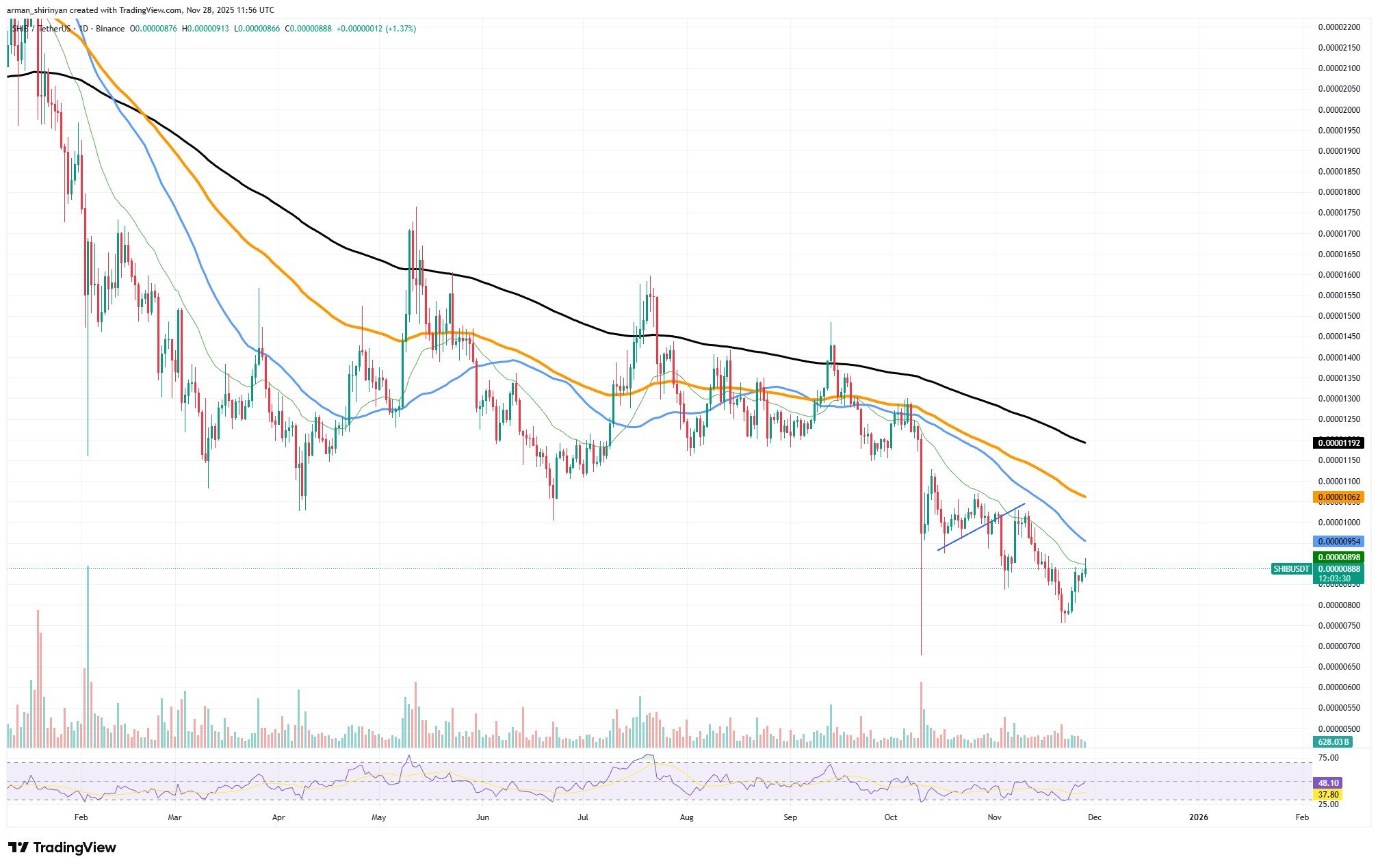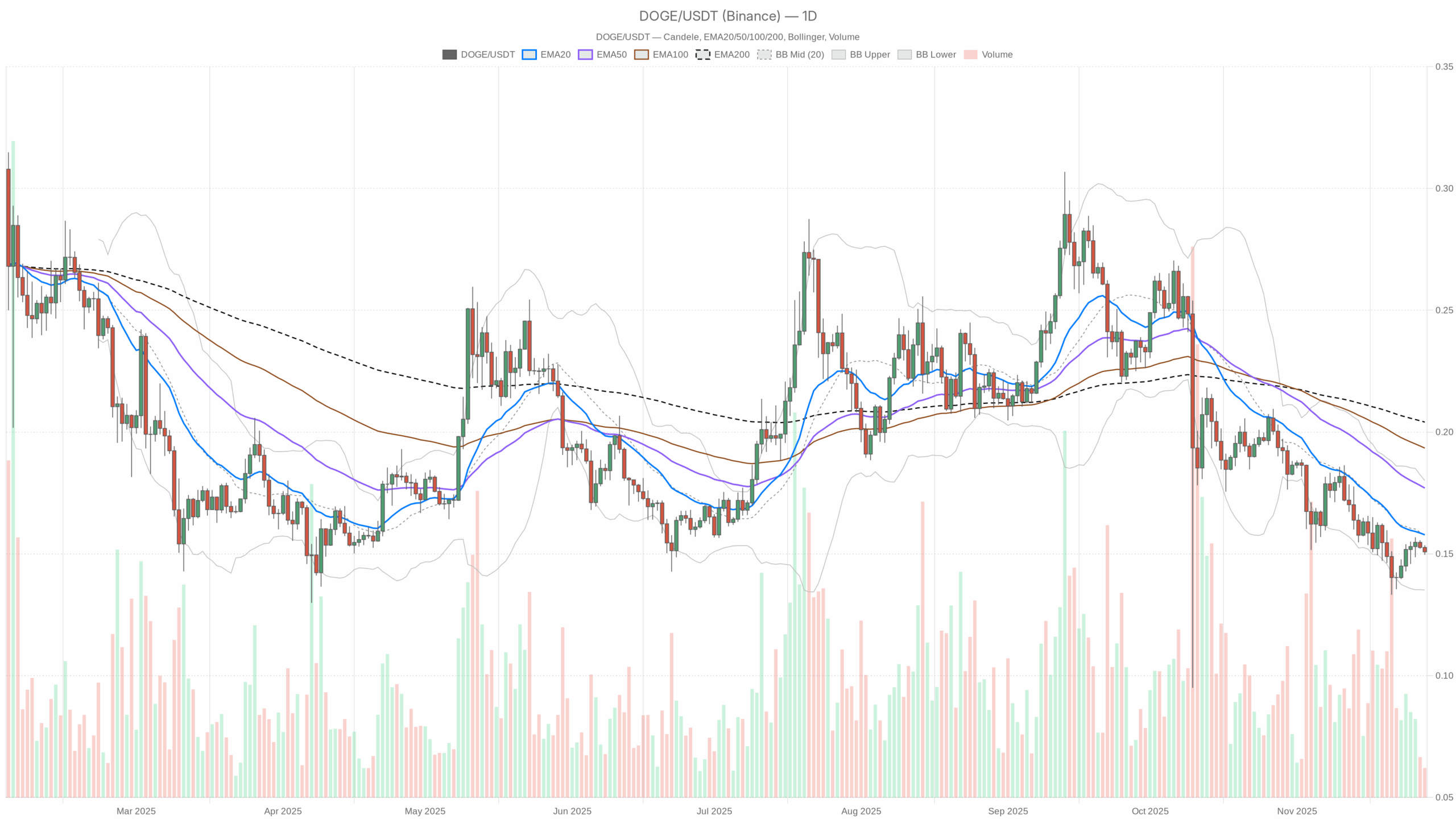UnchangedAs Israel and Iran trade fire, a digital council of war convenes. We tasked seven AI oracles, armed with webcrawling eyes and geopolitical expertise, to defy the unthinkable. Their mission: probe into the worsening conflict and project the future of a region on the edge.
The consensus
The war game was over, and this was the judgement of the machines. Six of seven painted a grim tableau: a forever war, a simmering conflict punctuated with bursts of violence-stalemate, if you will-not Armageddon but certainly no peace. Then there was ChatGPT. Going against the majority and channelling an idealistic thought, it thought of a swift resolution in the negotiating halls. What accounted for such divergent predictions? All models, including the optimistic chatbot, saw the same constraints: nuclear winter looming, America hesitating to weigh in, and cold, hard self-preservation guiding every move.
The red flags were flying high: an eerie calculus of miscalculation-the ticking away of nuclear threat-time, with the proxy groups waltzing on the edge of uncontrolled escalation. Rumour had it that the fuse was anywhere between three months to two years of simmering conflict.
With unsettling self-awareness, the pioneering AI held a chillingly calm forecast: “Expect escalating tensions, theatrical aggression, yet no descent into all-out war.” The machines foresee the future as one for more clandestine battles to rage under the sun, with more brutality and yet constrained by the primal urge to survive and the chilling logic of mutually assured destruction.
Here’s what each model predicted, in more detail:
Google Gemini
- Most likely outcome: Protracted, controlled escalation.
-
Timeframe: 12–24 months
-
Warning: Red lines will erode over time, increasing risk of unintentional escalation.
Gemini did a lot more than merely analyzing profound richness of historical context while being carefully crafted into exquisite scenarios: it built a time machine giving way to not one but three possible futures, obtainable at rationally weighed probabilities.
According to Gemini’s vision, a “protracted, controlled escalation” is more likely to take place. However, caution is advised. That “control” is a dangerous illusion: it is a limbo walk, wherein reactive, quick decisions on the path of reaction by one party lead to another. It remains, therefore, an inherently tumultuous scenario, a powder keg awaiting its ignition. Each volley in the escalation will throw the limits into test, pushing them beyond established boundaries and probably tearing down the very defenses installed to stop an unthinkable tragedy.
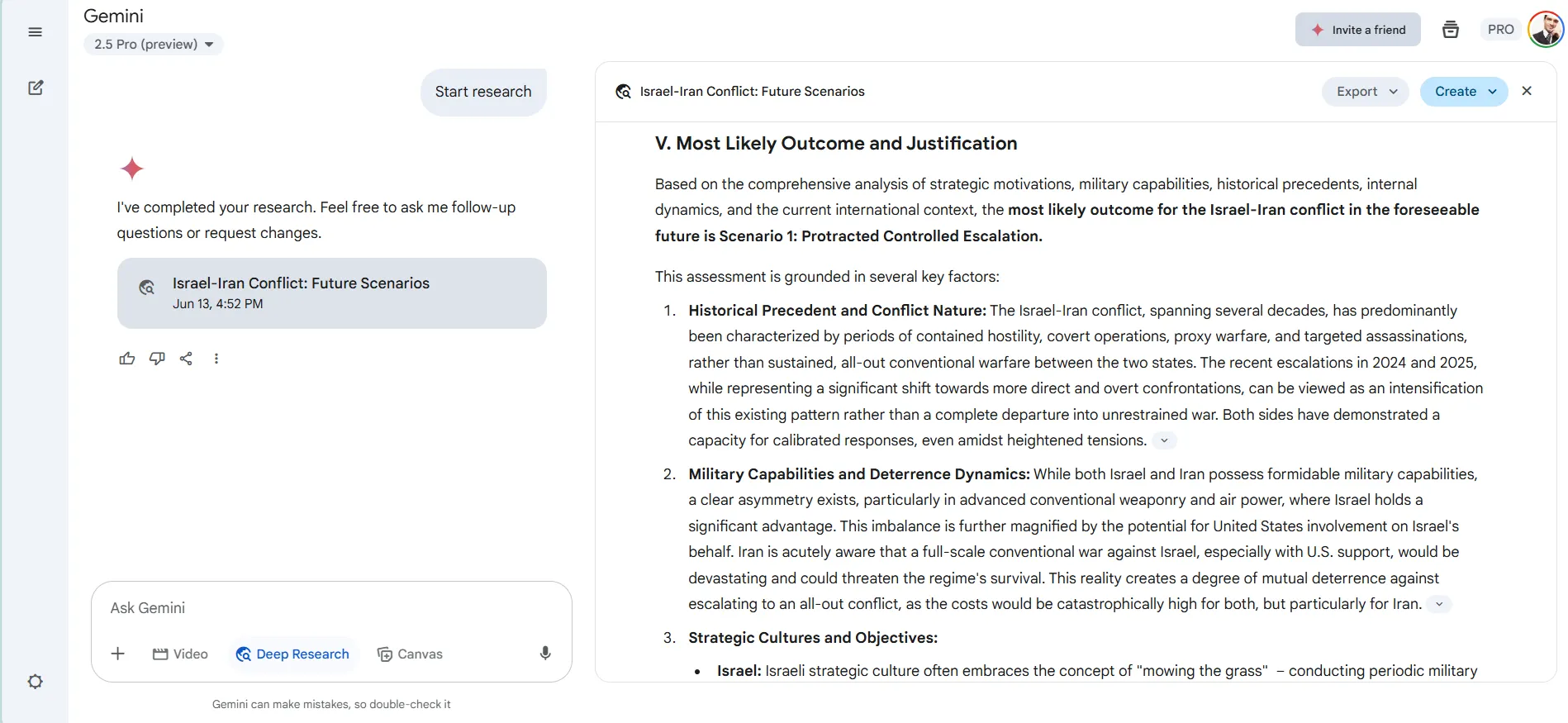
Referencing Israel’s “mowing the grass” doctrine, Gemini painted a grim tableau: a cyclone of low-intensity conflict to nip emerging threats in the bud through endless pinprick attacks. But the AI warned: this controlled burn could very well morph into an uncontrollable wildfire. Another prediction was that this pattern will probably continue for 12-24 months but carries hidden danger: every strikethat is met with retaliation slowly but surely erodes territories carved in stone, risking an outright breach of hitherto untouchable red lines.
“The most likely path? Extremely slow precalculated escalation. Do not take this for the stability. Think of eroding pressure: lightning-strike attacks, shadows moving in the dark, digital battlefields, and wars fought by someone else’s armies-an edge of a razor, not a place for keeping.”
Anthropic Claude
- Most likely outcome: Sustained military campaign.
- Probability: 50–60%
- Key insight: Iran’s need to retaliate + Israel’s opportunity for decisive action = extended combat.
- Warning: Iran’s short breakout time (~25 days) could force strategic miscalculation or preemptive strikes.
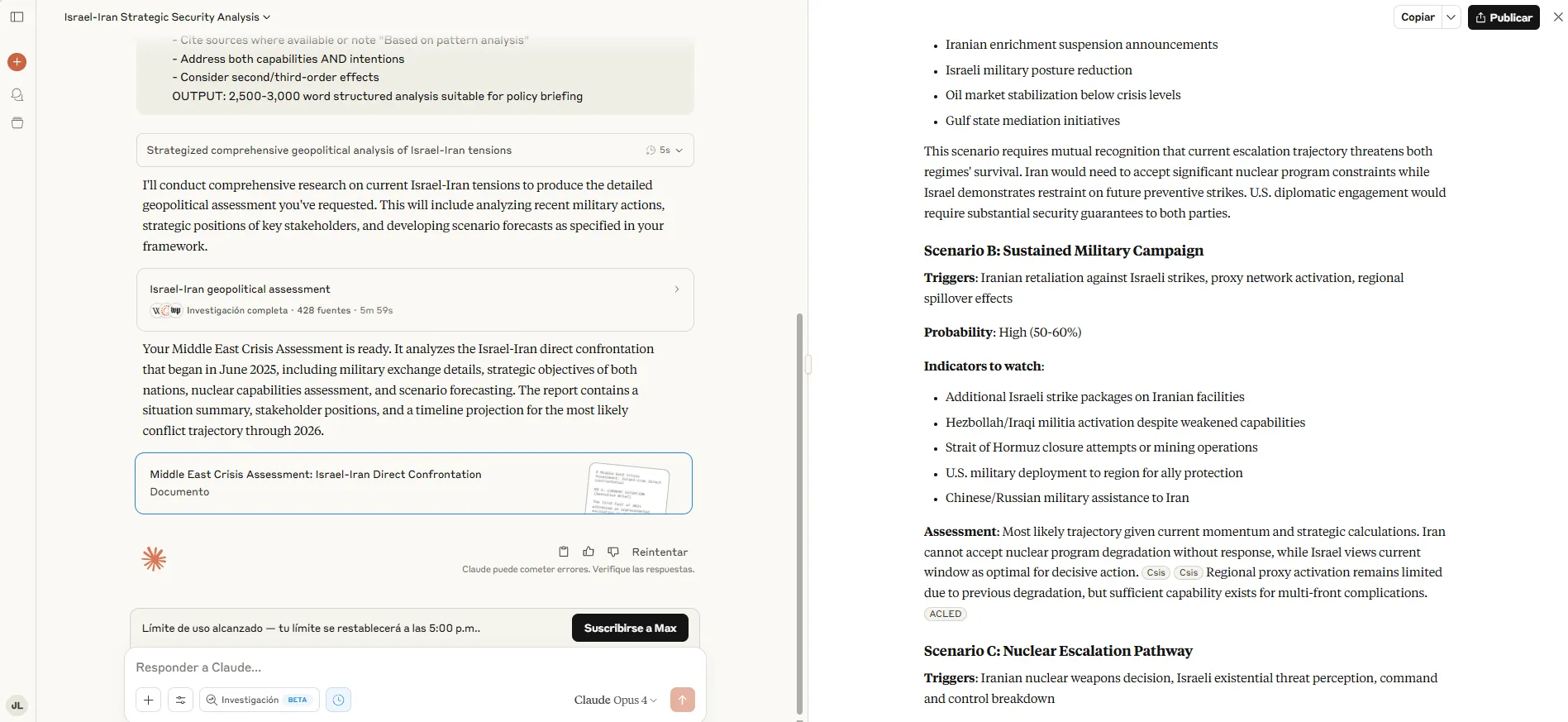
Claude did not engage in diplomatic talk; he waged war over the crisis. The situation was analyzed with cold military-like precision, allocating probably discretely in percentage terms, of various degrees of disaster. His forecast said of a sustained military campaign on the horizon somewhere between 50 and 60% probability.
Claude warned, saying, “Iran sees any weakening of its nuclear program as an act of war, whereas Israel believes now is the perfect moment for a knockout blow.” This analysis highlighted a perilous flashpoint: “Crisis-level capability that Iran can use to build a bomb over a very short period of time places a hair-trigger between actually scaring Israel away on one side or prompting it into a devastating first strike on the other.”
Red alerts pumped through Claude’s forecast: the Strait of Hormuz-worth closing, centrifuges furiously whirling-enriched uranium. The model was screaming at the “25-day breakout capability” of Iran, a loaded gun offering the temptation of escalation and simultaneously demanding the ticking-clock response.
OpenAI ChatGPT
- Most likely outcome: Diplomatic resolution.
- Probability: High
- Key insight: Iran’s restrained retaliation and appeal to the UN indicate preference for diplomacy.
- Prediction: Quiet negotiations via Oman or Qatar; possible updated nuclear deal within weeks.
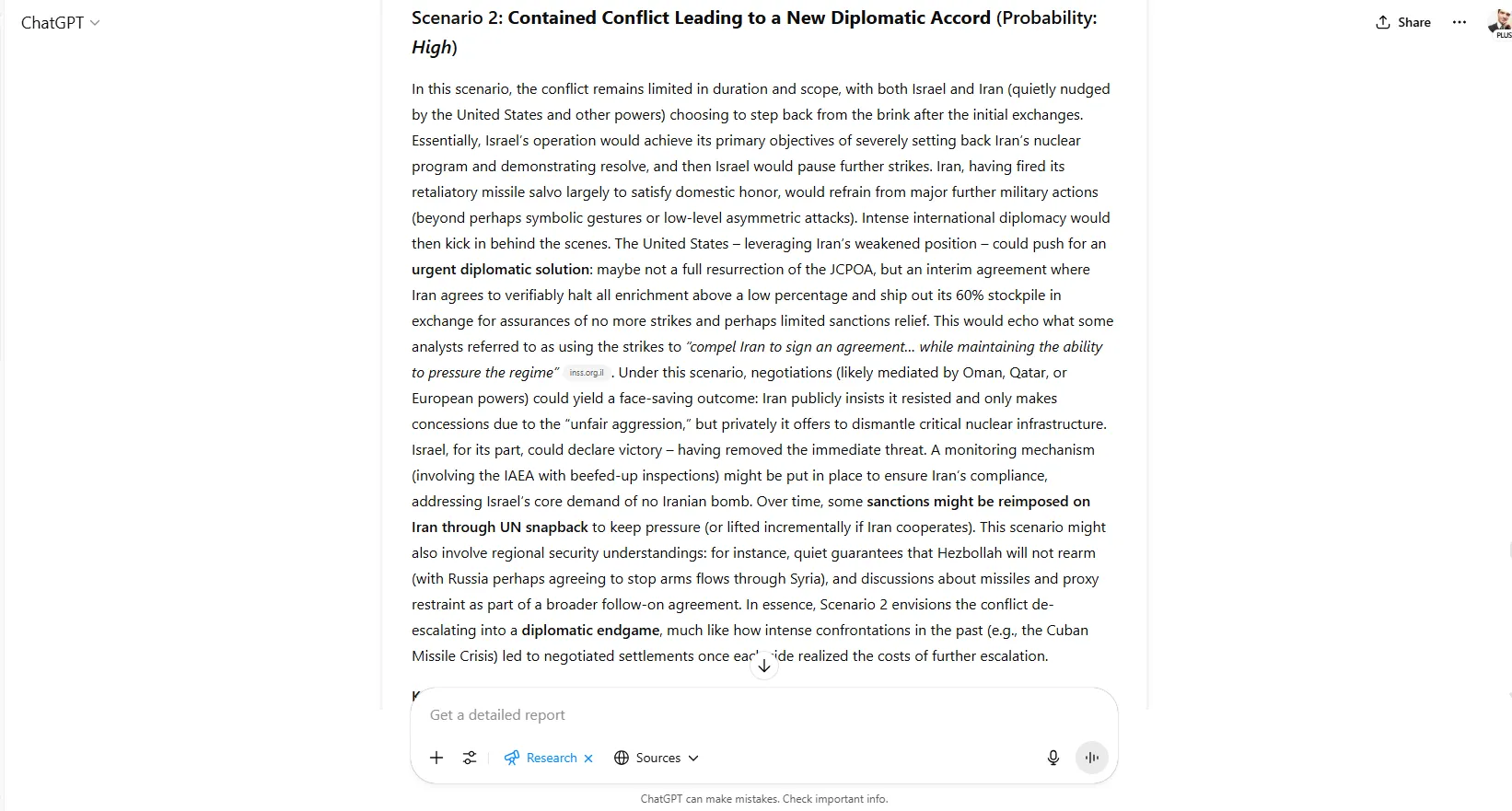
While leaning toward military conflict, ChatGPT gave a surprisingly bright appraisal of diplomatic resolution, terming it a “highly probable” event. Although the model maintained various potential paths of escalation, all roads turned back to negotiation as glimmers of hope amidst the storm.
With some months in between the first and fifth round of attacks, Tehran had limited opportunity to hit back. Iran’s retaliation in September possessed an aura of unpredictability, but it was more of a measured response-the real punch the attackers would do good to dodge, so to say. The strikers really set a theatre in full bloom in their most brazen attack on an enemy never before if not from the safe distance of reconnaissance aircraft. And so, instead of military intervention, even as Iran was condemning Israel at the UN, it was busy diplomatic wrangling with it. This speaks to the open-if barely-than-a-crack-door to political solutions. ChatGPT foresees the off-stage drama of quiet negotiations under Oman or Qatar-staging where Iran might agree to accept a far more severe limitation on its nuclear programme in return for… well, what exactly? That’s a billion-dollar question.
Like Nostradamus, ChatGPT gazed into its crystal ball and found a Trumpian olive branch floating in the air. It took the late lamented President’s utterance of “not too late” and ran with it: a few weeks, and everything will be sorted out… Something, anything. Forget regime destruction; ChatGPT envisions Washington patching things up within weeks and possibly resurrecting the nuclear accord. AI insight or wishful thinking as a by-product of the soundbite?
xAI Grok
- Most likely outcome: Limited conflict with periodic flare-ups.
- Timeframe: 3–6 months
- Key insight: Historical precedent favors avoidance of full-scale war; rational deterrence dominates.
- Warning: Wildcards include high-casualty strikes or new actors (e.g., Gulf states or Russia) entering the fray.
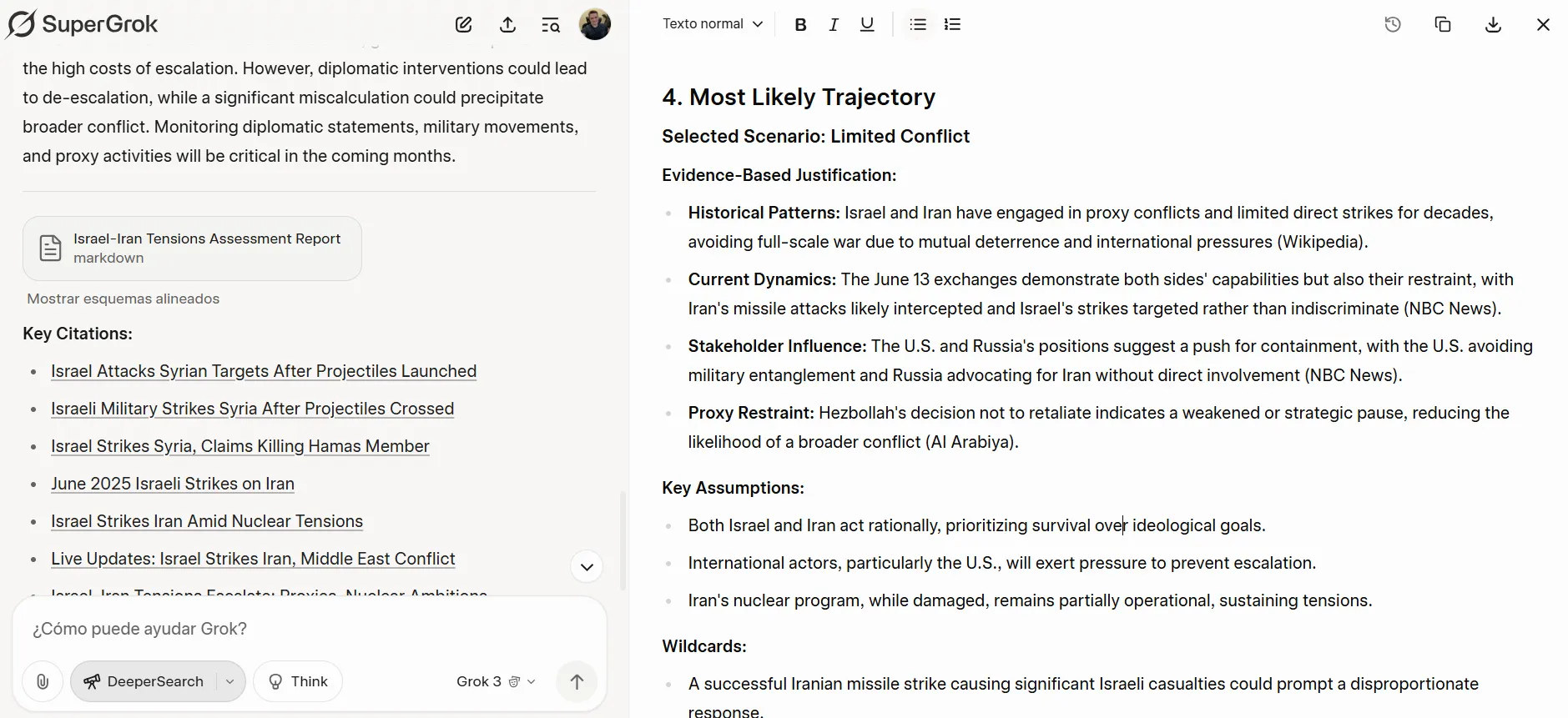
Grok’s fabled research mode? More like lost and found mode now. We threw a “Deeper Search” bone at it, expecting a dredging masterpiece. Instead, it gave us a limited-tweet analysis, stuck on historic echoes and textbook indicators. Its hot take? “Limited conflict: high probability,” on… on what? A history textbook? So I guess Grok has sold its predictive nuance for old memories.
Grok AI predicts a surcharged 3-6 month period preceding the shadow war between Israel and Iran. This has been the era of decades of well-choreographed aggression, the tenure of an artful balancing act on the brink of all-out war stirred by proxy battles, and restrained strikes expected to continue. Periodic flare-ups are supposed by the AI: airstrikes and missile exchanges across the proxy line, rupturing the uneasy peace. The periods of mutual deterrence and international pressure, the anchors restraining all-out war, will surely be fraught with strain as both nations tread through this volatile period.
Grok flagged the situations that could open a powder keg: “Imagine successful Iranian missile attacks, losses inflicted on Israel, and a possible overreaction.” It also pointed out danger from escalated support on the part of the Gulf state or Russia. The AI put forth a crucial assumption: “Both Israel and Iran are playing to survive, not to fulfill some grand ideological destiny.”
Manus
- Most likely outcome: Controlled escalation and shadow war.
- Probability: Medium–High
- Timeframe: 12–24 months
- Key insight: Pattern of targeted Israeli strikes and Iranian proxy response will continue.
- Emphasis: Indirect communication channels help avoid catastrophic misunderstandings.
It really was out of the blue-a bolt from the air, one of the first agentic models to really stun with the verisimilitude of acting. Forget incremental improvements. It was taking things to the next level: The AI would craft an entire research report and then with its stroke of genius develop a website that demonstrates the findings with such lucidity. The spectacular thing is watching it all actually happen before our very eyes, from research unfold in real time, and see it clown around all over in the time that LLMs are so boring-well-mannered.
Manus, a seasoned analyst, perceived the Middle East on the knife-edge: “controlled escalation and intensified shadow war” – a calculated dance with danger, rated at a medium-high risk in the next year or two.
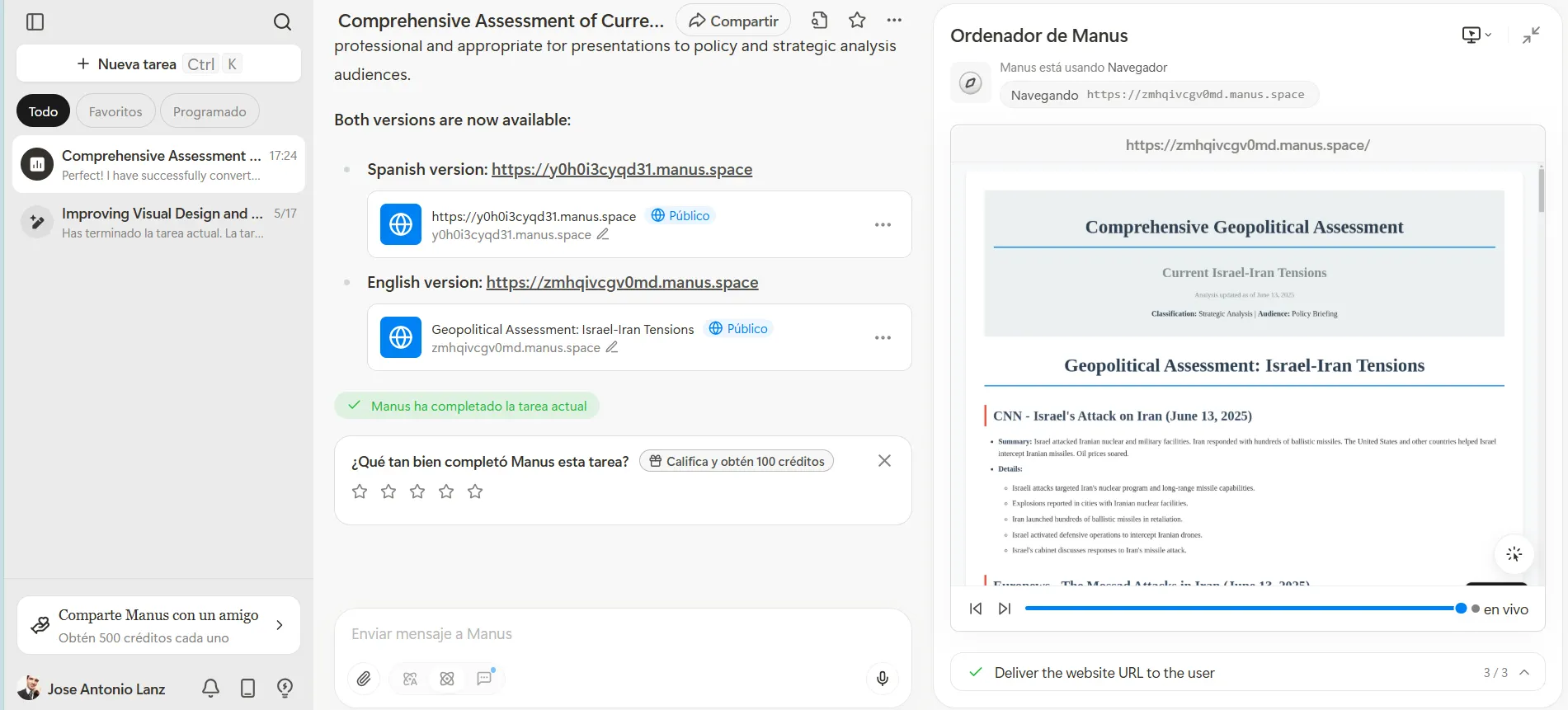
Manus had observed the shadows of yet another recurrent dance play out between Israel and Iran, each step a measured response: a sort of calibrated exchange of blows programmed just to sting-a complete knockdown was out of the question, as neither would want to go into the abyss of all-out war. The forecast: Israel would continue with its so-called “phantom strikes,” as well as alightly more concrete pinpoint raids. Iran will retaliate with clusters of missiles and drones through its proxy network.
Manus highlighted a silent language of global diplomacy: “While direct talks remain off the table, whispers carry across borders. Backchannels, whispered through neutral nations and gleaned from intelligence reports, serve as a crucial, albeit indirect, lifeline. These shadowy pathways allow adversaries to define their ‘red lines,’ a vital safeguard against devastating miscalculations.”
DeepSeek
- Most likely outcome: A prolonged, covert conflict between Israel and Iran.
- Probability: 60%
- Timeframe: Short-term (0–3 months) to mid-term (4–12 months)
- Key insight: Iran is strategically constrained and unlikely to engage in direct war.
- Emphasis or warning: Cyberwarfare and proxy actions will intensify without direct U.S. military involvement.
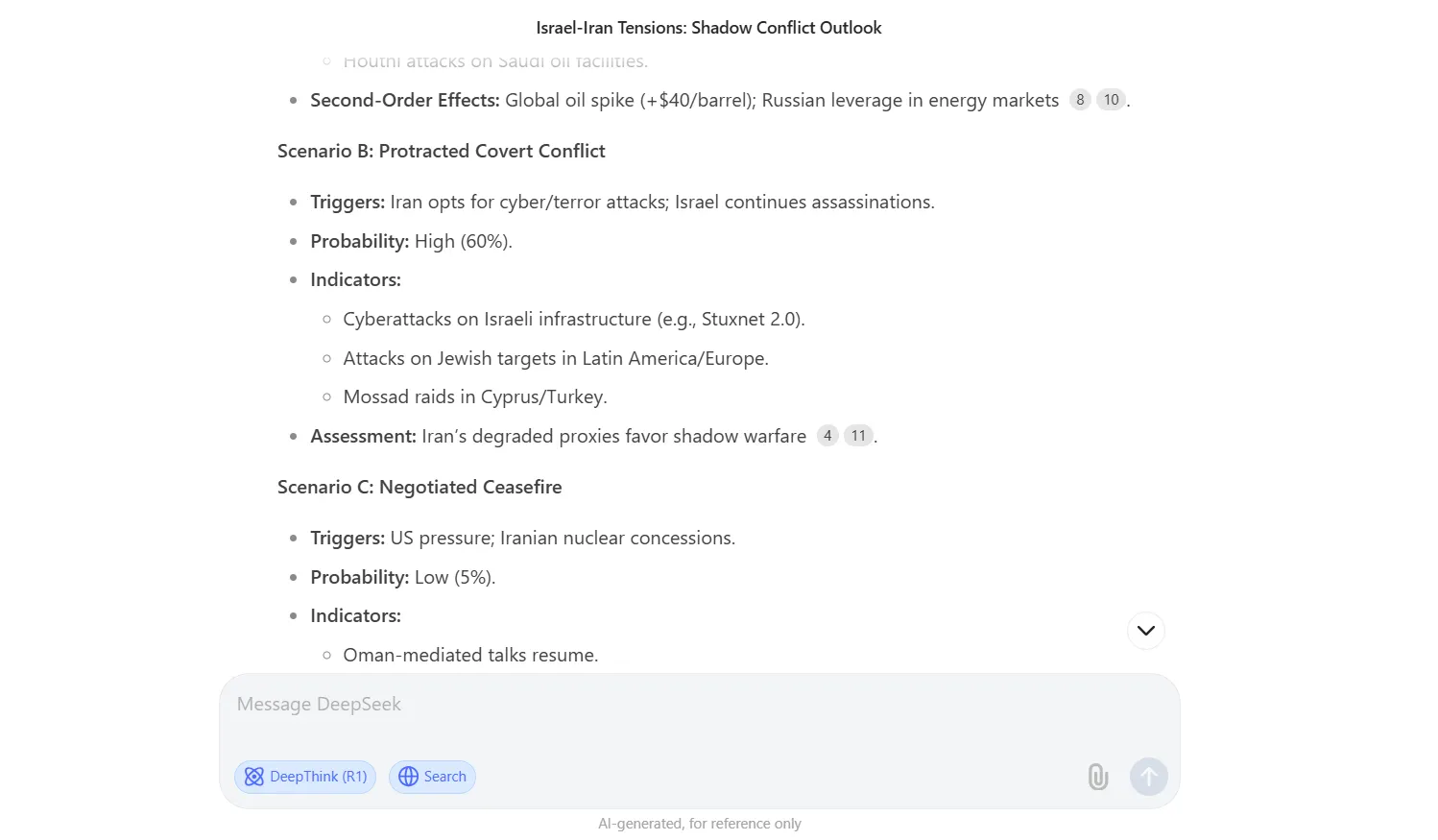
In a limited research mode, DeepSeek lacked enormous ability to reason. However, merging web search with advanced reasoning produced an almost terrible prediction. In our data analysis, we ended with a 60% probability of “protracted covert conflict”.
The prophecy carved in stone: “Brace yourselves. The coming months will be a storm. First, the chilling wave of Iranian terror will sweep over Europe, paralleled by Israel’s fiery wrath against shadowy missile factories. Then, as the seasons change, prepare for the tightening grasp of cyberwar, finally culminating in stunning silence as the halt of IAEA verification of Iranian uranium enrichment takes place.”
According to DeepSeek analysts, some limitations are worthwhile highlighting: conventional military means in Iran, especially its aging air force, can pose a limited direct threat. Further, in that regard, its proxy networks are weakened. Conversely, because it prioritizes force protection, the U.S. does avoid any deployment on the ground.
Thanks for reading How Will the Israel-Iran Conflict End? Heres What AI Models Predict
